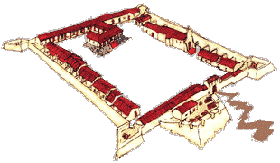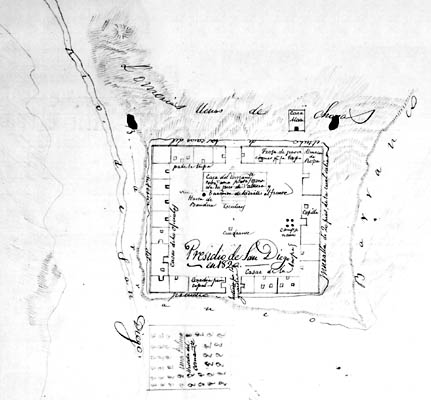
Today's s Presidio of San Diego commemorates the beginning of mission endeavor and European settlement in California. During the century that followed, the Presidio, its mission (completely restored in the early 1930's), and fortifications underwent a number of name changes as control of San Diego passed from Spain to Mexico and ultimately to the United States. The religious ceremony of July 1, 1769, was followed by the formal founding of El Presidio Real (a fort until it was legally established as a Presidio in 1774, now located in San Diego's "Old Town;" surrounded by a modern American city) on July 16, adjoining the first mission in Alta California, San Diego de Alcala. After a destructive Indian attack in August, the Spaniards erected a crude stockade on Presidio Hill to protect both the mission and the tiny colony. By the end of March 1770, the colonists had completed the stockade, mounted two bronze cannon, and built wooden houses with tule roofs.
The commandant's residence was situated in the center of the Presidio. On the east side of the square were a chapel, storehouses, and the cemetery; on the south side were the gate and guardhouse; and around the other sides were the soldiers' barracks. To remove his converted Indians from the destructive influence of the presidial garrison, Father Francisco Palou in 1774 moved the mission to a new site, six miles to the northeast, the present site of San Diego Mission. In 1778 the Presidio's original wooden walls and buildings began to be replaced with adobe structures. From 1795 to 1796 an esplanade, powder magazine, flagpole, and additional barracks were added to the Presidio, and Castillo de Guijarros-the harbors first fortification-was erected on the east side of Point Loma It in cluded a battery designed to mount ten cannon, an adobe built powder magazine, and barracks.
As the Spanish period drew to a close, the garrison of the Presidio increased, with 50 cavalrymen added in 1819 to the force of about 100 soldiers. The total Spanish population of San Diego and its near environs in that year was about 450, in addition to about 6,800 Indian neophytes. Under Mexican control, however, the size of the garrison and the condition of the Presidio declined rapidly after 1830. In 1831 the Mexican government withdrew the rest of the troops. In 1836 the Presidio was dilapidated and Castillo de Guijarros in ruins.
By 1839 the Presidio was a complete ruin, with much of its stone and adobe removed to erect houses in the new pueblo of San Diego, founded in 1835.
When the United States occupied San Diego in 1846, neither the Presidio nor Castillo de Guijarros had any military value. But the 1838 built earthwork on Presidio Hill was incorporated in what was called Fort DuPont (for the captain of the sloop-ofwar Cyane) and later variously known as Garrison at San Diego, Fort San Diego, or Fort Stockton (after Commodore Robert F. Stockton, who occupied the site later in the same year). In 1847, when tile Mormon Battalion and its commander, General Philip St. George, were stationed at San Diego, they found that the Mission San Diego de Alcala had been abandoned for at least a dozen years. Cooke settled his troops on open ground near the chapel. later, a regular Army garrison used the chapel as a barracks, calling it Post at Mission San Diego.
Prior to the Civil War, San Diego became of military significance for a number of reasons, among them the disruptions caused by tile Mexican war, the discovery of gold, and Indian depredations. Several new military posts in southern California were established. San Diego's chief contribution was as a depot from which supplies were distributed to Camp (later Fort) Yuma, 225 miles distant, and other posts in the southern department. In 1858-59, when Colonel Joseph K. F. Mansfield inspected the Department of the Pacific's military posts for the second time, he found the San Diego Depot unoccupied. Reoccupied in 1860, it was first called the Post of New San Diego and, later, San Diego Barracks, remaining continuously active until 1920.
The site of the Presidio of San Diego was rescued from complete oblivion in 1929 by the donation of a 37 acre parcel to tile city of San Diego, to be used for park purposes. Presidio Park, formally landscaped, includes the Serra Museum as its principal architectural feature. Built in 1929, the museum houses a large collection of archaeological and historical memorabilia related to Spanish colonization and early California history. The museum's library contains both original and published records of the history of the city and the region. Most of the former site of the Presidio lies in front of the museum. Construction of the San Diego River dike and the Mission Valley Road had destroyed part of the site, and another small section of the site lies beneath a park road. In the center of the site stands the Junipero Serra Cross, erected in 1913, built from the many pieces of brick and floor tile found on the site. A number of fort plans relating to California's four presidios were discovered in 1982 in the Bancroft library at Berkeley. The most valuable in the collection is the 1820 plan of San Diego Presidio (See below). Archaeologists have been working on that site for more than 20 years without the guidance of a plan. its availability should be of material assistance to the San Diego archeological program.

- Presidio
and Mission of San Diego
- Presidio Real de San Diego, 1769
- Posts at Mission San Luis Rey de Francia
- Military Personnel at the Presidio of San Diego and Fort Guijarros

- Presidio Real de San Diego, 1769
- Archaeology Field Report on the Search for Fort
Guijarros
- Lost Cannons of Fort Guijarros
- San Diego State University archaeological papers on Fort Guijarros

- Searching for Fort Guijarros

- A Translation of Chapter VI of Don Pedro de Lucuze's 1772 Principios de Fortificacion as it Relates to the Design of the Fort at Punta de Guijarros, San Diego, California

- The Servants of Punta de Guijarros

- Lost Cannons of Fort Guijarros